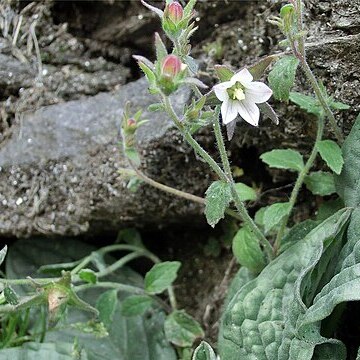Plants perennial. Roots carrot-shaped, sometimes slightly thicker than stems. Stems single, sometimes 2 or rarely several from a single caudex, ascending or erect, up to 60 cm tall, hirsute. Lower leaves winged-petiolate, upper leaves sessile; blade elliptic, rhombic-elliptic, or oblong, 1-4 × 0.3-1.5 cm, abaxially densely hirsute or hispid only along veins, adaxially appressed hispid, margin denticulate or almost entire, apex acuminate, acute, or obtuse. Flowers pendent, terminal, sometimes in cymes. Hypanthium obconic or campanulate, hispid; calyx lobes deltoid, narrowly triangular, or subulate, 2-8 mm, abaxially hispid (sometimes only along veins), margin entire or rarely serrulate. Corolla purple, blue-purple, or blue, tubular-campanulate, 4-15 mm; lobes ca. 1/2 as long to ± as long as tube. Style less than 2/3 as long as corolla, included. Capsule obconic, obovoid, or globose. Seeds golden brown, oblong or elliptic, compressed. Fl. May-Sep. 2n = 24, 28.
More
A herb. It keeps growing from year to year. The roots are carrot shaped. The stems are 60 cm tall. The lower leaves have winged leaf stalks and the upper leaves do not have leaf stalks. The leaves are 1-4 cm long by 1-2 cm wide. There can be teeth along the edges. The flowers hang down and are purple or blue.
It is a temperate plant. It grows on grassy slopes between 1,000-1,400 m above sea level. In Sichuan and Yunnan.

